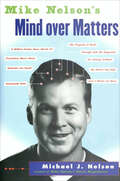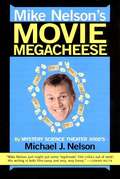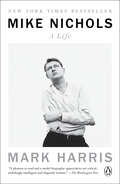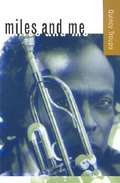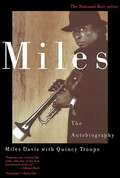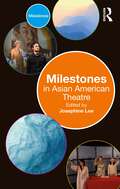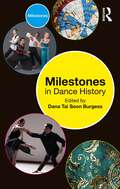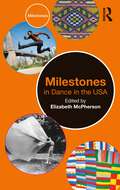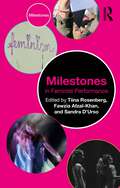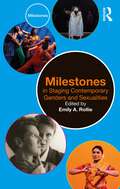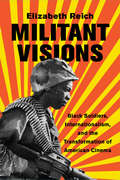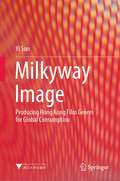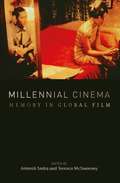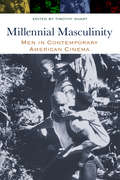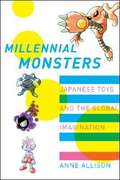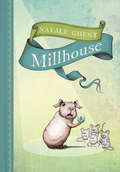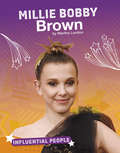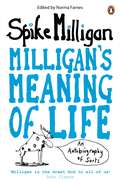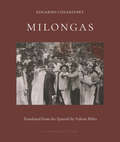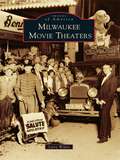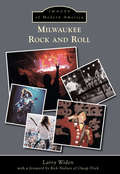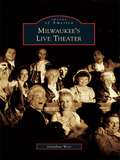- Table View
- List View
Mike Nelson's Mind Over Matters
by Michael J. NelsonWhy do some people retain cute baby-talk names for their relatives (like "Num-Num" and "Pee-Paw") well into middle age? How should a reasonable person respond when Olivia Newton-John sings, "Have you never been mellow?" Who's responsible for the sorry state of men's fashion, and is it the same guy who invented the jerkin? Is there any future in being a Midwesterner? Can you really enjoy your lunch when the restaurant is decorated to look like an African plain? How come women keep dozens of bottles and jars of moisturizers, unguents, and lotions around -- all of them half empty? In more than 50 hilarious all-new essays, one of America's brightest young humorists -- the head writer and on-air host of the legendary TV series Mystery Science Theater 3000 -- finds the fun in all aspects of the human condition, no matter how absurd. Join Mike Nelson on an angst-filled visit to a health spa; shopping sessions at Home Depot and Radio Shack; adventures in the very amateur musical theater; a gut-busting discourse on the history of television; ruminations on his roles as husband, father, and citizen; and much, much more.
Mike Nelson's Movie Megacheese
by Michael J. NelsonYou might think that after ten seasons on the Peabody Award-winning TV series Mystery Science Theater 3000, Mike Nelson has seen enough bad movies for one lifetime. As the guys at Cahiers du Cinema say, au contraire! Hollywood's spigot of stupidity shows no sign of slowing, and cheesy films continue to flood our multiplexes and gunk up our home entertainment centers at an alarming rate. This dire situation calls for a specialist. A professional. An expert in wading through motion pictures so vile that they aren't released; they escape. We need Mike Nelson! Hey, settle down there, pal--you got him! In more than sixty laugh-out-loud reviews and essays featuring his unique combination of erudite wit and shameless clowning, this screenscarred veteran takes us deep into the recesses of cinematic cheese. He examines legendary showbiz families like Culkin, Baldwin, and Estevez; uncovers an ancient quatrain in which Nostradamus foretells the coming of David Hasselhoff; makes the case for the Food Network and the Three Stooges; and skewers all kinds of movies, including Lost in Space, Twister, Anaconda, The Postman, Spring Break, My Best Friend's Wedding, The Bridges of Madison County, The Blair Witch Project, and many, many more. Here is a film critic for the rest of us: the outrageous, hilarious Mike Nelson.
Mike Nichols: A Life
by Mark HarrisA magnificent biography of one of the most protean creative forces in American entertainment history, a life of dazzling highs and vertiginous plunges--some of the worst largely unknown until now--by the acclaimed author of Pictures at a Revolution and Five Came BackMike Nichols burst onto the scene as a wunderkind: while still in his twenties, he was half of a hit improv duo with Elaine May that was the talk of the country. Next he directed four consecutive hit plays, won back-to-back Tonys, ushered in a new era of Hollywood moviemaking with Who's Afraid of Virginia Woolf?, and followed it with The Graduate, which won him an Oscar and became the third-highest-grossing movie ever. At thirty-five, he lived in a three-story Central Park West penthouse, drove a Rolls-Royce, collected Arabian horses, and counted Jacqueline Kennedy, Elizabeth Taylor, Leonard Bernstein, and Richard Avedon as friends. <P><P>Where he arrived is even more astonishing given where he had begun: born Igor Peschkowsky to a Jewish couple in Berlin in 1931, he and his younger brother were sent to America on a ship in 1939. The young immigrant boy caught very few breaks. He was bullied and ostracized--an allergic reaction had rendered him permanently hairless--and his father died when he was just twelve, leaving his mother alone and overwhelmed. <P>The gulf between these two sets of facts explains a great deal about Nichols's transformation from lonely outsider to the center of more than one cultural universe--the acute powers of observation that first made him famous; the nourishment he drew from his creative partnerships, most enduringly with May; his unquenchable drive; his hunger for security and status; and the depressions and self-medications that brought him to terrible lows. It would take decades for him to come to grips with his demons. In an incomparable portrait that follows Nichols from Berlin to New York to Chicago to Hollywood, Mark Harris explores, with brilliantly vivid detail and insight, the life, work, struggle, and passion of an artist and man in constant motion. Among the 250 people Harris interviewed: Elaine May, Meryl Streep, Stephen Sondheim, Robert Redford, Glenn Close, Tom Hanks, Candice Bergen, Emma Thompson, Annette Bening, Natalie Portman, Julia Roberts, Lorne Michaels, and Gloria Steinem. <P>Mark Harris gives an intimate and evenhanded accounting of success and failure alike; the portrait is not always flattering, but its ultimate impact is to present the full story of one of the most richly interesting, complicated, and consequential figures the worlds of theater and motion pictures have ever seen. It is a triumph of the biographer's art. <P><P><b>A New York Times Bestseller</b>
Miles and Me
by Quincy TroupeQuincy Troupe's candid account of his friendship with Miles Davis is a revealing portrait of a great musician and an intimate study of a unique relationship. It is also an engrossing chronicle of the author's own development, both artistic and personal. As Davis's collaborator on Miles: The Autobiography, Troupe--one of the major poets to emerge from the 1960s--had exceptional access to the musician. This memoir goes beyond the life portrayed in the autobiography to describe in detail the processes of Davis's spectacular creativity and the joys and difficulties his passionate, contradictory temperament posed to the men's friendship. It shows how Miles Davis, both as a black man and an artist, influenced not only Quincy Troupe but whole generations. Troupe has written that Miles Davis was "irascible, contemptuous, brutally honest, ill-tempered when things didn't go his way, complex, fair-minded, humble, kind and a son-of-a-bitch." The author's love and appreciation for Davis make him a keen, though not uncritical, observer. He captures and conveys the power of the musician's presence, the mesmerizing force of his personality, and the restless energy that lay at the root of his creativity. He also shows Davis's lighter side: cooking, prowling the streets of Manhattan, painting, riding his horse at his Malibu home. Troupe discusses Davis's musical output, situating his albums in the context of the times--both political and musical--out of which they emerged.
Miles: The Autobiography
by Quincy Troupe Miles DavisFor more than forty years Miles Davis has been in the front rank of American music. Universally acclaimed as a musical genius, Miles is one of the most important and influential musicians in the world. The subject of several biographies, now Miles speaks out himself about his extraordinary life. Miles: The Autobiography,like Miles himself, holds nothing back. For the first time Miles talks about his five-year silence. He speaks frankly and openly about his drug problem and how he overcame it. He condemns the racism he has encountered in the music business and in American society generally. And he discusses the women in his life. But above all, Miles talks about music and musicians, including the legends he has played with over the years: Bird, Dizzy, Monk, Trane, Mingus, and many others. The man who has given us some of the most exciting music of the past few decades has now given us a compelling and fascinating autobiography, featuring a concise discography and thirty-two pages of photographs.
Milestones in Asian American Theatre (Milestones)
by Josephine LeeThis introduction to Asian American theatre charts ten of the most pivotal moments in the history of the Asian diaspora in the USA and how those moments have been reflected in theatre. Designed for weekly use on Asian American theatre courses, ten chosen milestones move chronologically from the earliest contact between Japan and the West through the impact of the Vietnam War and the resurgent "yellow peril" hysteria of COVID-19. Each chapter emphasizes common questions of how racial identities and relationships are understood in everyday life as well as represented on the theatrical stage and in popular culture. Milestones are a range of accessible textbooks, breaking down the need-to-know moments in the social, cultural, political, and artistic development of foundational subject areas.
Milestones in Dance History (Milestones)
by Dana Tai Soon BurgessThis introduction to world dance charts the diverse histories and stories of dancers and artists through ten key moments that have shaped the vast spectrum of different forms and genres that we see today. Designed for weekly use in dance history courses, ten chosen milestones move chronologically from the earliest indigenous rituals and the dance crazes of Eastern trade routes, to the social justice performance and evolving online platforms of modern times. This clear, dynamic framework uses the idea of migrations to chart the shifting currents of influence and innovation in dance from an inclusive set of perspectives that acknowledge the enduring cultural legacies on display in every dance form. Milestones are a range of accessible textbooks, breaking down the need-to-know moments in the social, cultural, political, and artistic development of foundational subject areas.
Milestones in Dance in the USA (Milestones)
by Elizabeth McPhersonEmbracing dramatic similarities, glaring disjunctions, and striking innovations, this book explores the history and context of dance on the land we know today as the United States of America. Designed for weekly use in dance history courses, it traces dance in the USA as it broke traditional forms, crossed genres, provoked social and political change, and drove cultural exchange and collision. The authors put a particular focus on those whose voices have been silenced, unacknowledged, and/or uncredited – exploring racial prejudice and injustice, intersectional feminism, protest movements, and economic conditions, as well as demonstrating how socio-political issues and movements affect and are affected by dance. In looking at concert dance, vernacular dance, ritual dance, and the convergence of these forms, the chapters acknowledge the richness of dance in today’s USA and the strong foundations on which it stands. Milestones are a range of accessible textbooks, breaking down the need-to-know moments in the social, cultural, political, and artistic development of foundational subject areas. This book is ideal for undergraduate courses that embrace culturally responsive pedagogy and seek to shift the direction of the lens from western theatrical dance towards the wealth of dance forms in the United States.
Milestones in Feminist Performance (Milestones)
by Fawzia Afzal-Khan Tiina Rosenberg Sandra D’UrsoThis accessible introduction challenges fixed understandings of the geographical or conceptual "origins" of feminist performance, offering a fresh and open-ended guide to the moments and movements that have come to define this vital field.Designed for weekly use on performance studies courses, each of the book’s ten chapters highlights the key works of feminist performance, including performance art, live art, body art, activism, and theater. These milestones are all linked to acts of rupture and political reanimation, as artists broke with dominant understandings of gender, art, and value, that were taken to be insurmountable and static.Milestones are a range of accessible textbooks, breaking down the need-to-know moments in the social, cultural, political, and artistic development of foundational subject areas.
Milestones in Staging Contemporary Genders and Sexualities (Milestones)
by Emily A. RollieThis introduction to the staging of genders and sexualities across world theatre sets out a broad view of the subject by featuring plays and performance artists that shifted the conversation in their cultural, social, and historical moments.Designed for weekly use in theatre studies, dramatic literature, or gender and performance studies courses, these ten milestones highlight women and writers of the global majority, supporting and amplifying voices that are key to the field and some that have typically been overlooked. From Paula Vogel, Split Britches, and Young Jean Lee to Werewere Liking, Mahesh Dattani, Yvette Nolan, and more, the chapters place artists’ key works into conversation with one another, structurally offering an intersectional perspective on staging genders and sexualities.Milestones are a range of accessible textbooks, breaking down the need-to-know moments in the social, cultural, political, and artistic development of foundational subject areas.
Militant Visions: Black Soldiers, Internationalism, and the Transformation of American Cinema
by Elizabeth ReichMilitant Visions examines how, from the 1940s to the 1970s, the cinematic figure of the black soldier helped change the ways American moviegoers saw black men, for the first time presenting African Americans as vital and integrated members of the nation. In the process, Elizabeth Reich reveals how the image of the proud and powerful African American serviceman was crafted by an unexpected alliance of government propagandists, civil rights activists, and black filmmakers. Contextualizing the figure in a genealogy of black radicalism and internationalism, Reich shows the evolving images of black soldiers to be inherently transnational ones, shaped by the displacements of diaspora, Third World revolutionary philosophy, and a legacy of black artistry and performance. Offering a nuanced reading of a figure that was simultaneously conservative and radical, Reich considers how the cinematic black soldier lent a human face to ongoing debates about racial integration, black internationalism, and American militarism. Militant Visions thus not only presents a new history of how American cinema represented race, but also demonstrates how film images helped to make history, shaping the progress of the civil rights movement itself.
Militante Marienfrömmigkeit: Schillers „Jungfrau von Orleans“ und die Politisierung der Religion um 1800 (Studien zu Literatur und Religion / Studies on Literature and Religion #7)
by Ulrich PortDas Buch lotet die Beziehungen zwischen Literatur, Religion, Politik und (Kriegs)gewalt um 1800 aus. Im Zentrum steht Friedrich Schillers Tragödie „Die Jungfrau von Orleans“. Dieses Drama dient als Brennspiegel, umgekehrt auch als Prisma für eine Untersuchung der Revolutionsepoche, die die Interferenzen von Französischer Revolution, Koalitionskriegen, Religion und Literatur in neuem Licht erscheinen lässt. Diskutiert werden das komplexe Verhältnis des Autors Schiller zur Religion, die politische Theologie, die populare Religiosität und die Religionskritik im Aufklärungszeitalter sowie die Dialektik von (theatralisierter) Dechristianisierung und Resakralisierung im ersten Revolutionsjahrzehnt. Besondere Schwerpunkte bilden eine politisierte Marienfrömmigkeit und das literarische Nachleben von Märtyrerdrama und Heiligenlegende um 1800.
Milkyway Image: Producing Hong Kong Film Genres for Global Consumption
by Yi SunThis book adopts an integrative research framework that primarily combines industrial and discourse analysis to investigate the company Milkyway Image, drawing upon literature that studies film studios and the practices of film production, distribution, and reception. The history of the Hong Kong-based film production company Milkyway Image from its founding in 1996 to the present exemplifies the metamorphosis of the post-return Hong Kong film industry to an era characterised by Hong Kong’s integration into a Chinese national context and the transnationalisation of world cinema. It shows that contemporary Hong Kong cinema’s transition resists a monolithic chronicle and instead represents a narrative combining the perspectives of different interest groups and a complex process of compliance and resistance, negotiation and contestation. The meaning of Milkyway’s films shifts as they are circulated across cultures and viewed within diverse frameworks, and our understanding of Hong Kong cinema is subject to varying contexts and historical configurations. For researchers in film and media studies and those who have a general interest in Hong Kong cinema, Asian cinema, or contemporary film culture, this book reveals how a variety of industry and cultural bodies have become co-creators of meaning for a film production house, and how the company operates as a co-creator of the discourse that surrounds it.
Millennial Cinema: Memory in Global Film
by Amresh Sinha Terence McsweeneyIn spite of the overwhelming interest in the study of memory and trauma, no single volume has yet explored the centrality of memory to films of this era in a global context; this volume is the first anthology devoted exclusively to the study of memory in twenty-first-century cinema. Combining individual readings and interdisciplinary methodologies, this book offers new analyses of memory and trauma in some of the most discussed and debated films of the new millennium: Pan's Labyrinth (2006), The Namesake (2006), Hidden (2005), Eternal Sunshine of the Spotless Mind (2004), Oldboy (2003), City of God (2002), Irréversible (2002), Mulholland Drive (2001), Memento (2000), and In the Mood for Love (2000).
Millennial Cinema: Memory in Global Film
by Amresh Sinha Terence Eds. McSweeneyIn spite of the overwhelming interest in the study of memory and trauma, no single volume has yet explored the centrality of memory to films of this era in a global context; this volume is the first anthology devoted exclusively to the study of memory in twenty-first-century cinema. Combining individual readings and interdisciplinary methodologies, this book offers new analyses of memory and trauma in some of the most discussed and debated films of the new millennium: Pan's Labyrinth (2006), The Namesake (2006), Hidden (2005), Eternal Sunshine of the Spotless Mind (2004), Oldboy (2003), City of God (2002), Irréversible (2002), Mulholland Drive (2001), Memento (2000), and In the Mood for Love (2000).
Millennial Masculinity: Men in Contemporary American Cinema
by Timothy SharyIn virtually every aspect of culture-health, marriage, family, morals, politics, sex, race, economics-American men of the past two decades have faced changing social conditions and confronted radical questions about themselves. In Millennial Masculinity: Men in Contemporary American Cinema, editor Timothy Shary collects fourteen contributions that consider male representation in films made at the turn of the century to explore precisely how those questions have been dealt with in cinema. Contributors move beyond the recent wave of "masculinity in crisis" arguments to provide sophisticated and often surprising insight into accessible films. Chapters are arranged in four sections: "Performing Masculinity" includes a discussion of Adam Sandler and movies such as Milk; "Patriarchal Problems" looks at issues of fathers from directors such as Martin Scorsese, Wes Anderson, and David Fincher; "Exceptional Sexualities" examines male love and sex through movies like Brokeback Mountain and Wedding Crashers; and "Facing Race" explores masculinity through race in film. Sean Penn, Jackie Chan, Brad Pitt, Will Smith, and Philip Seymour Hoffman are some of the actors included in these analyses, while themes considered include police thrillers, psychotic killers, gay tensions, fashion sense, and the burgeoning "bromance" genre. Taken together, the essays in Millennial Masculinity shed light on the high stakes of masculine roles in contemporary American cinema. Film and television scholars as well as readers interested in gender and sexuality in film will appreciate this timely collection.
Millennial Monsters: Japanese Toys and the Global Imagination
by Anne AllisonMillennial Monsters explores the global popularity of Japanese youth goods today while it questions the make-up of the fantasies and the capitalistic conditions of the play involved. Arguing that part of the appeal of such dream worlds is the polymorphous perversity with which they scramble identity and character, the author traces the postindustrial milieu from which such fantasies have arisen in postwar Japan and been popularly received in the United States.
Millhouse
by Natale GhentFans of the I, Freddy series and Charlotte's Web will be won over by this charming, delightfully told and illustrated story of a petshop misfit -- a hairless guinea pig with a penchant for Shakespeare. Millhouse is a faint-hearted, hairless guinea pig. A great lover of all things theatrical, most especially the work of William Shakespeare, Milly longs for the limelight and someone to love. However, after the death of his beloved owner, the great actor Sir Roderick Lord Kingswagger, Millhouse is abandoned to a neglected and dusty pet shop filled with other rodents -- some rude, some odd, some cute and some downright frightening. Finding himself a reviled outcast and a target of the nasty Pepper Brown ferret, Millhouse sets about trying to find a way back to the theater and a happy home, and in doing so experiences more drama than he could ever have imagined.
Millicent
by Millicent Collinsworth Jan WinebrennerLike a modern-day Scarlett O'Hara, Millicent was born into a Southern world of privilege -- a moneyed environment of homesteads, servants, family tradition, and pride. The halcyon days of her childhood left Millicent ill-prepared for the tragedy that would stalk her family and almost destroy it. Like dark cloak, her father's manic depression shrouds her family in shame, forcing them to leave the home they love and journey into a world of poverty, fear, and danger. Millicent becomes a pawn in her family's struggle for survival, nourished only by her dream of restoring her family's honor. But the journey home is a long one. Millicent must overcome sexual and physical abuse, failed relationships, and a perfectionism that leads to bulimia. As if that were not enough, a freak accident leads her to question her sanity and eventually results in her blindness. And so she must learn to live in a world without light... but, in the end, not without live.
Millie Bobby Brown (Influential People)
by Martha LondonMillie Bobby Brown rose to fame playing the character Eleven on the Netflix TV show Stranger Things. Now she's using her fame to try to make the world a better place. Learn more about Millie's acting and activism!
Milligan's Meaning of Life: An Autobiography of Sorts
by Spike MilliganSpike Milligan's legendary war memoirs are a hilarious and subversive first-hand account of the Second World War, as well as a fascinating portrait of the formative years of this towering comic genius, most famous as writer and star of The Goon Show. They have sold over 4.5 million copies.With his lightning-quick wit, unbridled creativity and his ear for the absurd, Milligan revolutionised British comedy, leaving a legacy of influence that stretches from Monty Python's Flying Circus to the work of self-confessed acolytes such as Eddie Izzard and Stephen Fry today.Throughout his life, Milligan wrote prolifically - scripts, poetry, fiction, as well as several volumes of memoir, in which he took an entirely idiosyncratic approach to the truth. In this ground-breaking work, Norma Farnes, his long-time manager, companion, counsellor and confidante, gathers together the loose threads, reads between the lines and draws on the full breadth of his writing to present his life in his own words: an autobiography - of sorts.From his childhood in India, through his early career as a jazz musician and sketch-show entertainer, his spells in North Africa and Italy with the Royal Artillery, to that fateful first broadcast of The Goon Show and beyond into the annals of comedy history, this is the autobiography Milligan never wrote.
Milongas
by Edgardo CozarinskyWith an introduction by award-winning author Alberto Manguel, Milongas is Edgardo Cozarinsky's love letter to tango, and the diverse array of people who give it life.From tango&’s origins in the gritty bars of Buenos Aires, to milongas tucked away in the crypt of a London Church, a café in Kraków, or the quays of the Seine, Cozarinsky guides us through a shape-shifting dance&’s phantasmagoric past. In neighborhood dance halls vibrant and alive through the early hours of the morning, where young and old, foreign and native, novice and master come together to traverse borders, demographics, and social mores, &“it is impossible to distinguish the dance from the dancer.&” As conspiratorial as he is candid, Cozarinsky shares the secrets and culture of this timeless dance with us through glimmering anecdote, to celebrate its traditions, evolution, and the devotees who give it life.
Milwaukee Movie Theaters: A Pictorial History Of Milwaukee's Movie Theaters (Images of America)
by Larry WidenPrior to World War II, there were 90 single-screen movie theaters in Milwaukee. By 1960, that number had been reduced by half. With the arrival of television for the home market, the golden age of the movie theater in Milwaukee was dead. Yet their ghosts continue to haunt the old neighborhoods. Churches, warehouses, stores, nightspots, and other businesses now occupy the former Tivoli, Paris, Roosevelt, and Savoy Buildings. Others are simply vacant hulks, decaying from the inside out. The Elite, Regent, Lincoln, and Warner are but a few of the many silent sentinels from the days when Milwaukee was in love with the movies.
Milwaukee Rock and Roll
by Larry Widen Rick Nielsen of Cheap TrickThe history of rock music in Milwaukee began at an age when some musicians played in a segregated part of the city. At the same time, a young singer named Buddy Holly kicked off a tour that ended with a plane crash in Iowa 11 days later. The following years brought the Beatles, Rolling Stones, and the rest of the British Invasion. In the late 1960s came acid rock, civil unrest, and Summerfest, a music festival that continues to this day. Milwaukee has had its moments in the spotlight: Bob Dylan left the stage after two songs in 1964, Bruce Springsteen's 1975 concert was delayed for hours while police searched for a bomb in the theater, hundreds of Black Sabbath fans rioted after a 1980 show, and the Plasmatics' Wendy O. Williams was beaten by police in 1981. And then there was the helicopter crash in which blues guitarist Stevie Ray Vaughn perished.
Milwaukee's Live Theater (Images of America)
by Jonathan WestMilwaukee's live theater scene is the sum of several exciting parts. For many, Milwaukee live theater means world-class productions done by resident actors at one of the nation's leading regional theaters. For others, it has been defined by the machinations of a respected experimental theater troupe that traveled throughout Europe in the 1980s and was once honored with an Obie Award. There was a time when Milwaukee live theater meant a big top arena where some of the biggest stars of American musical theater frolicked and played for local audiences. Audiences in Milwaukee have enjoyed the classics, new plays, and contemporary hits performed by never-say-die producers who boast personalities larger than the stages their companies play upon. The Milwaukee theater style is not fussy or overblown. It is informed by a thrilling past, buoyant future, unsurpassed community support, and unfailing devotion to solid midwestern work ethics channeled into artistic innovation. Simply put, Milwaukee's live theater scene is the best-kept artistic secret in the United States.
